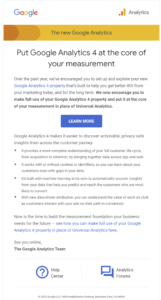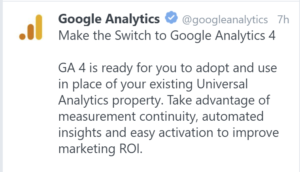Google’s latest web analytics offering, GA4, has been out in the wild for over a year now: long enough to change its name. It is being improved all the time and recently introduced a 360 version.
The guidance from Google until recently, was that companies were advised to get GA4 set up on their site in tandem with their existing Universal Analytics (hereafter called GA3) implementation in order to get a feel for the new product, wait for new features to roll out and begin generating historical data for when the time was right to consolidate their tracking using only GA4.
This week, Google started to announce that the time is right to begin the switchover, with email and social media communications pushing the same message:


Is GA4 ready for prime time?
Whilst the list of pros begins to grow longer – including custom reporting such as funnels and segment overlap only available to GA3 360 customer being available in GA4, more robust pathing reporting etc – there are still some lingering cons.
These cons individually might be considered small enough to allow for certain sites to switch to GA4, but when added together mean most ecommerce sites would likely see a significant fall in data capture and analytical functionality.
Amongst these cons are:
- Limited data filters – there are only a few filters than can be applied to GA4 data, primarily to exclude internal traffic. As some of our clients have recently found, any bot traffic that comes to the site is reliant on Google filtering it out rather than GA4, and this isn’t always 100% accurate. Any filters you may have to manipulate data in GA3 are not available.
- Ecommerce reporting is more limited, and there is currently no way to track data with a product-scoped custom dimension in GA4.
- Attribution reporting is limited – at the time of writing, there is no data-driven attribution and no multi-channel funnel reporting available.
- No calculated metrics are available; ie the ability to define your own metrics using pre-existing metrics in the implementation.
- Whilst GA4 does have “comparisons” which are part segment, part filtered view, they’re not able to fully replace the loss of views in GA4. This is something that Google is working on.
- No customTask facility yet. With GA3, customTask can be used to carry out all sorts of useful tasks, such as capture the client Id or dedupe transactions before the hit is processed by Google. Whilst there are workarounds for this, being able to do it directly within the tag would bring massive flexibility and strength to GA4’s tracking.
For the time-being, we’re maintaining our existing advice: set up a GA4 implementation to run parallel to your GA3 implementation, and through planned phases build it up to approximate your GA3 implementation.
Whilst GA4 is clearly the future of Google Analytics, in our opinion it is not ready to take over from GA3 just yet.
So, implement GA4 and keep them both running for now.

